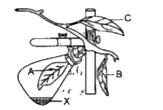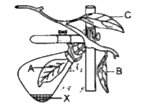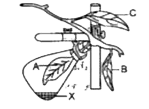Give an experiment to demonstrate root pressure in a plant.
Experiment to Demonstrate Root Pressure in a Plant
Materials Needed:
1. A well-potted plant
2. A sharp knife or scissors
3. A glass tube (same diameter as the plant stem)
4. Rubber tubing
5. Water
6. Marker for marking water levels
Steps:
1. Select a Plant:
- Choose a healthy, well-watered potted plant. Ensure that the plant has been watered adequately prior to the experiment to ensure sufficient root pressure.
Hint: A plant with a strong root system will show more pronounced root pressure.
2. Cut the Stem:
- Using a sharp knife or scissors, cut the stem of the plant a few centimeters above the ground. This will help in observing the root pressure effectively.
Hint: Make a clean cut to avoid damaging the plant excessively.
3. Attach the Glass Tube:
- Take the glass tube and connect it to the cut end of the stem using the rubber tubing. Ensure that the glass tube fits snugly to prevent any leakage of water.
Hint: Check that the connection is tight to avoid any loss of water during the experiment.
4. Fill the Glass Tube:
- Fill the glass tube with water and mark the initial water level as L1.
Hint: Use a permanent marker to ensure the level is visible for comparison later.
5. Wait and Observe:
- Leave the plant undisturbed for about 2 to 3 hours. This waiting period allows the roots to generate root pressure.
Hint: Ensure the plant is in a stable environment during this time, away from direct sunlight or disturbances.
6. Measure the Water Level Again:
- After the waiting period, check the water level in the glass tube and mark this new level as L2.
Hint: Make sure to measure the water level accurately to observe any changes.
7. Calculate the Difference:
- Determine the difference between the two water levels (L2 - L1). This difference indicates the root pressure exerted by the plant.
Hint: A significant increase in water level suggests that root pressure is actively pushing water upward through the stem.
Conclusion:
The difference in water levels (L2 - L1) demonstrates the root pressure in the plant. If the water level has risen, it indicates that the roots are generating hydrostatic pressure, pushing water upwards through the stem.
---
1. A well-potted plant
2. A sharp knife or scissors
3. A glass tube (same diameter as the plant stem)
4. Rubber tubing
5. Water
6. Marker for marking water levels
- Choose a healthy, well-watered potted plant. Ensure that the plant has been watered adequately prior to the experiment to ensure sufficient root pressure.
- Using a sharp knife or scissors, cut the stem of the plant a few centimeters above the ground. This will help in observing the root pressure effectively.
- Take the glass tube and connect it to the cut end of the stem using the rubber tubing. Ensure that the glass tube fits snugly to prevent any leakage of water.
- Fill the glass tube with water and mark the initial water level as L1.
- Leave the plant undisturbed for about 2 to 3 hours. This waiting period allows the roots to generate root pressure.
- After the waiting period, check the water level in the glass tube and mark this new level as L2.
- Determine the difference between the two water levels (L2 - L1). This difference indicates the root pressure exerted by the plant.
The difference in water levels (L2 - L1) demonstrates the root pressure in the plant. If the water level has risen, it indicates that the roots are generating hydrostatic pressure, pushing water upwards through the stem.
Topper's Solved these Questions
- TRANSPORT IN PLANTS BOOK - ICSECHAPTER - TRANSPORT IN PLANTS EXERCISE - REVIEW QUESTIONS (Give reasons for the following)
5 Videos
- TRANSPORT IN PLANTS BOOK - ICSECHAPTER - TRANSPORT IN PLANTS EXERCISE - REVIEW QUESTIONS (Miscellaneous questions with answers)
15 Videos
- TRANSPORT IN PLANTS BOOK - ICSECHAPTER - TRANSPORT IN PLANTS EXERCISE - REVIEW QUESTIONS (Short answer type questions)
25 Videos
- THE LIVING WORLD BOOK - ICSECHAPTER - THE LIVING WORLD EXERCISE - Ncert Exercises (Differentiate Between )
4 Videos
Similar Questions
Root pressure is a
View SolutionDescribe an experiment to demonstrate the excess pressure inside a soap bubble.
View SolutionGive an experiment to demonstrate Hill's reaction.
View SolutionDescribe an experiment to demonstrate that air exerts pressure.
View SolutionDesign an experiment to demonstrate hydrotropism.
View SolutionExperiment demonstrating osmosis
View SolutionDefine the term transpiration. Design an experiment to demonstrate this process.
View SolutionThe diagram below represents an experiment to demonstrate a particular aspect of a physiological process in plants. Study the diagram and answer the questions that follows:

Explain the term Destarching.
View SolutionThe diagram below represents an experiment to demonstrate a particular aspect of a physiological process in plants. Study the diagram and answer the questions that follows:

In what way will the three leaves A, B and C differ at the end of the experiment when tested with iodine solution?
View SolutionThe diagram below represents an experiment to demonstrate a particular aspect of a physiological process in plants. Study the diagram and answer the questions that follows:

Write the overall chemical equation for the process mentioned.
View Solution
